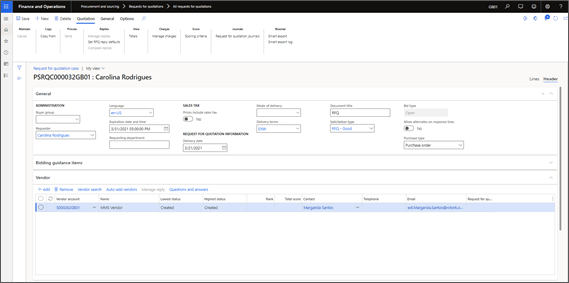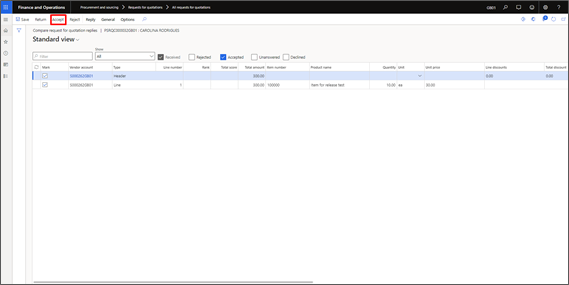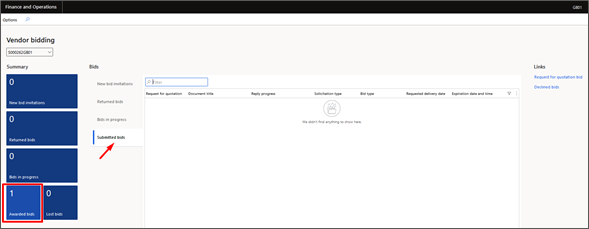
Microsoft Dynamics 365 Finance and Operations – Vendor Collaboration: RFQ creation
A two-part blog series by Margarida Santos and Carolina Rodrigues on Vendor Collaboration. In Part 2, Margarida and Carolina take a closer look at the Request For Quotations (RFQ) of the feature.
In every business, regardless of the industry, it is a challenge to maintain a good relationship with all vendors. Vendor management is an important process and, if managed efficiently, can provide better trade agreements and other benefits such as price discounts. The vendor collaboration feature streamlines your supply chain management, allowing an automated and more efficient process.
The vendor portal allows real-time integration with an ERP system, which is a quick way to improve accuracy, speed, and error elimination within the procurement process. In most businesses, request for quotations (RFQ) and purchase orders (POs) are created within the finance system, being sent to their vendors by email. The vendor collaboration feature removes the manual effort. With the vendor portal configured for your business, you can send an RFQ for several vendors at once, collect and compare their bids and select the one that is most advantageous for you. Finally, a PO is created automatically for the selected vendor, who can confirm it with only one click on the vendor portal.
-
Request for quotation creation
Company side
Now, that the vendor is set up a request for quotation (RFQ) can be created on the company side by the customer user in Procurement and sourcing > Request for quotation > All request for quotation. During RFQ creation select the solicitation type which has a scoring method associated and ensure the expiration date of the RFQ is in the future.
The RFQ will have a header and a line section. The header section indicates key information such as the expiration date and time and the delivery date whereas the line section indicates the products, quantity, unit price and any discount information. Before sending the RFQ to the vendor the following configuration needs to be in place: i) “Default RFQ reply fields” in Quotation tab > Replies > Set RFQ reply defaults; ii) List of vendor account under the “Vendor” section in the Header view; iii) Questionnaire under “Questionnaire” section in the Header view.

Figure 1 RFQ Header view
After filling in all this information, the request can be sent to the vendor by clicking in the Quotation tab > Process > Send. At this point, a message will be displayed indicating that the RFQ has been sent to the selected vendors.
Vendor side
On the vendor side, the vendor user can open the “Vendor bidding” workspace and find the RFQ in the “New bid invitations” section. After opening and reviewing the RFQ details, the vendor user will click on “Bid” and enter the necessary information which will update the Bid progress status to “Vendor is updating”. The vendor user can reply indicating the quantity, unit price, delivery date among other information.
The vendor can save and update the bid at any time prior to the expiration date. At this point, the record will move from the “New bid invitations” section to the “Bids in progress”. The vendor must respond to the associated questionnaire by clicking on “Complete Questionnaire” under the questionnaire tab and click “End” to submit it. Finally, the bid can be submitted by clicking “Submit” in the top ribbon. At this point, the record will move from “Bids in progress” to “Submitted bids”.
Figure 2 Submission of Vendor Bids
Company side
On the company side, after all of the vendors have submitted the bids or the expiration date is due, the RFQ status will be updated to “Received” (in Procurement and sourcing > Request for quotations > All request for quotation). The customer user can compare the several bids from the different vendors in the Quotation tab > Replies > Compare views. After comparing the bids, the customer user can Accept the best bid(s) and reject the unwanted bids. Additionally, the bid can be returned to the vendor if changes are needed.

Figure 3 Comparison of RFQ replies
Once the RFQ is accepted a message will display indicating that the RFQ is posted and a purchase order is created automatically, based on the configuration in place.
Vendor side
On the Vendor side in the Vendor bidding workspace, the record will be moved from the “Submitted Bids” to “Awarded bids”.

Figure 4 Awarded bids in Vendor bidding workspace
Свързани новини
Expertise
Where is the construction industry heading on its digital journey?
Our author Sabrina Hilmer explores what’s moving the industry. The construction industry has now reached the point of intensively dealing…
Expertise
Can we improve margins in the construction sector?
Construction is renowned for competitive pricing and tight margins, which the industry has been trying to improve for years. Faced…